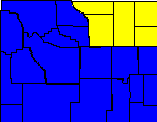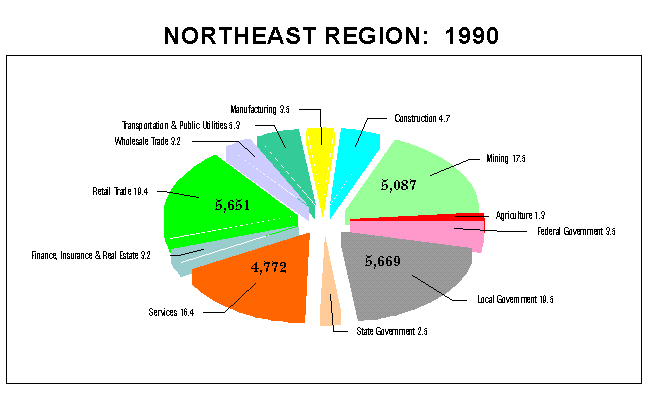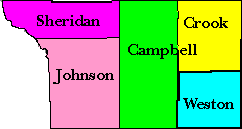
 | An Illustrated History of Employment (1990 & 1994) |
Employment in the Northeast Region in 1994 was led by the Retail Trade industry with 6,397 workers (19.9%). Following closely was Local Government with 5,966 workers (18.5%), Services with 5,691 workers (17.7%) and Mining with 4,999 workers (15.5%). The Northeast Region was similar to statewide data in 1994 in that Retail Trade was the number one industry and Mining ranked number four. Local Government in the Northeast Region (18.5%) was higher than in Wyoming (16.2%). Statewide, 20.3 percent of all workers were in the Services industry while in the Northeast, the proportion was 17.7 percent.
The Northeast Region’s two largest industries, Retail Trade and Local Government, traded places over the 1990 - 94 period. The largest industry in 1990, Local Government, fell to second place in 1994 while Retail Trade rose to first with 19.9 percent of covered employment. Over the period, Mining fell to fourth largest (15.5%) in employment as opposed to 17.5 percent in 1990. Services gained nearly one percent to become the third largest industry in 1994 (17.7%).
Campbell County, unlike the other counties, dominates the Northeast Region in the Mining industry. Nearly one-third of all jobs in Campbell County were found in Mining. Between 1990 and 1994 the percentage of Mining industry employment decreased, but remained stable in terms of total jobs (around 4,400). On the other hand, Local Government, the second largest industry in the county, has increased employment by 210 workers (2,523 to 2,733). Retail Trade increased its share of the employment also (from 2,371 to 2,717 workers). The percentage of Services employees remained constant (14.9%). Campbell County drives the region’s Mining employment and to some extent the state’s.
Crook County, with one of the smallest worker populations in the state, only had 9.9 percent of its jobs in 1990 involved in Mining. The proportion fell to 8.3 percent in 1994. Local Government maintained its total number of jobs in Crook County (exactly 460), but by 1994 had fallen 2.3 percent (27.8% to 25.5%). The winning industries in terms of increased employment were: Services (up 2.9%), Construction (up 2.0%), Retail Trade (up 1.1%) and Manufacturing (up 1.0%). Finance, Insurance, & Real Estate along with Transportation & Public Utilities suffered most, each with a decrease of more than one percent.
Three industries dominated Johnson County in 1994. They were Retail Trade (23.7%), followed by Local Government (22.6%) and Services (17.3%). In 1990, the combined category of Transportation & Public Utilities was the fourth largest industry in Johnson County. However, in 1994 it had fallen from 10.1 to 3.9 percent of all workers. All remaining industries maintained their percentages of workers below six percent in 1994.
Sheridan County had the same three top industries found in the region with Services, Retail Trade and Local Government. However, the county has a significant number of federal jobs (701 jobs or 6.9%), most of which are associated with the Veteran's Administration Hospital. Most of the other industry employment in Sheridan County hovers around five percent.
Weston County, similar in employment size to Crook County, has essentially five major industries. In 1994 they were: Local Government (24.8%), Retail Trade (19.7%), Services (12.5%), Mining (12.2%) and Manufacturing (9.7%). In the previous period, 1990, it had the same major industries. However, because of Weston County’s small labor force, any small numerical change vastly affects the industry proportions. Agriculture and Wholesale Trade are almost nonexistent in the county.




|
| Go Back To: |
| Table of Contents |
| Labor Market Information |
| Wyoming Job Network |
| Send Us Mail |